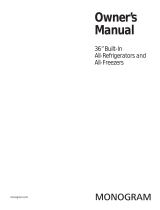
20 49-1000529 Rev.0
PERFORMANCE DATA SHEET Model: XWF or XWFE
Ŷ6\VWHPFHUWLILHGE\,$30257DJDLQVW16)$16,6WDQGDUGV3IRUWKHUHGXFWLRQRIFODLPVVSHFLILHGRQWKHSHUIRUPDQFH
data sheet and at iapmort.org.
Ŷ$FWXDOSHUIRUPDQFHPD\YDU\ZLWKORFDOZDWHUFRQGLWLRQV
It is essential that the manufacturer’s recommended installation,
maintenance and filter replacement requirements be carried out for
the product to perform as advertised. See Installation Manual for
Warranty information.
Application Guidelines/Water Supply Parameters
Service Flow 0.5 gpm (1.89 lpm)
Water Supply Potable Water
Water Pressure 25-120 psi (172-827 kPa)
Water Temperature 33°F-100°F (0.6°C-38°C)
Capacity 170 gallons (643.5 liters)
Substance Tested for Reduction
Influent challenge
concentration
(mg/L)
Maximum permissible
product water
concentration (mg/L)
Avg %
Reduction
Chlorine Taste and Odor 2.0 mg/L +/- 10% N/A 96.9
Chloramine Taste and Odor 3.0 mg/L +/- 10% 0.5 96.9
Particulate, Class I At least 10,000/mL N/A 91.4
Cysts 50,000/L N/A >99.99
Lead 0.15 0.01 98.85
Mercury 0.006 0.002 96.3
Asbestos 107 to 108 fibers/ L N/A >99
Toxaphene 0.015 +/- 10% 0.003 86.95
VOC (Chloroform surrogate chemical) 0.300 0.015 99.7
Alachlor 0.050 0.001 > 98
Atrazine 0.100 0.003 > 97
Benzene 0.081 0.001 > 99
Carbofuran 0.190 0.001 > 99
carbon tetrachloride 0.078 0.0018 98
chlorobenzene 0.077 0.001 > 99
chloropicrin 0.015 0.0002 99
2,4-D 0.110 0.0017 98
dibromochloropropane (DBCP) 0.052 0.00002 > 99
o-Dichlorobenzene 0.08 0.001 > 99
p-Dichlorobenzene 0.040 0.001 > 98
1,2-dichloroethane 0.088 0.0048 95
1,1-dichloroethylene 0.083 0.001 > 99
cis-1,2-dichloroethylene 0.170 0.0005 > 99
trans-1,2-dichloroethylene 0.086 0.001 > 99
1,2-dichloropropane 0.080 0.001 > 99
cis-1,3-dichloropropylene 0.079 0.001 > 99
dinoseb 0.170 0.0002 99
Endrin 0.053 0.00059 99
Ethylbenzene 0.088 0.001 > 99
ethylene dibromide (EDB) 0.044 0.00002 > 99
bromochloroacetonitrile 0.022 0.0005 98
dibromoacetonitrile 0.024 0.0006 98
dichloroacetonitrile 0.0096 0.0002 98
trichloroacetonitrile 0.015 0.0003 98
1,1-dichloro-2-propanone 0.0072 0.0001 99
1,1,1-trichloro-2-propanone 0.0082 0.0003 96
heptachlor (H-34, Heptox) 0.025 0.00001 >99
heptachlor epoxide 0.0107 0.0002 98
hexachlorobutadiene 0.044 0.001 > 98
hexachlorocyclopentadiene 0.060 0.000002 > 99
Lindane 0.055 0.00001 > 99
methoxychlor 0.050 0.0001 > 99
pentachlorophenol 0.096 0.001 > 99
simazine 0.120 0.004 > 97
Styrene 0.150 0.0005 > 99
1,1,2,2-tetrachloroethane 0.081 0.001 > 99
Tetrachloroethylene 0.081 0.001 > 99
Toluene 0.078 0.001 > 99
2,4,5-TP (silvex) 0.270 0.0016 99
tribromoacetic acid 0.042 0.001 > 98
1,2,4-Trichlorobenzene 0.160 0.0005 > 99
1,1,1-trichloroethane 0.084 0.0046 95
1,1,2-trichloroethane 0.150 0.0005 > 99
trichloroethylene 0.180 0.0010 > 99
bromoform 0.300 0.015 95
bromodichloromethane 0.300 0.015 95
chlorodibromomethane 0.300 0.015 95
xylenes 0.070 0.001 >99
Meprobamate 400 +/- 20% 60 95.5
Atenolol 200 +/- 20% 30 95.9
Carbamazepine 1400 +/- 20% 200 98.6
DEET 1400 +/- 20% 200 98.6
Metolachlor 1400 +/- 20% 200 98.7
Trimethoprim 140 +/- 20% 20 96.1
Linuron 140 +/- 20% 20 96.6
TCEP 5000 +/- 20% 700 98.1
TCPP 5000 +/- 20% 700 98.1
Phenytoin 200 +/- 20% 30 96
Ibuprofen 400 +/- 20% 60 95.9
Naproxen 140 +/- 20% 20 96.5
Estrone 140 +/- 20% 20 97.1
Bisphenol A 2000 +/- 20% 300 99.1
Nonyl phenol 1400 +/- 20% 200 97.3
PFOA/PFOS 1.5 mg/L +/- 10% 0.07 99.25
NOTE: While the testing was performed under standard
laboratory conditions, actual performance may vary.
Replacement Cartridge: XWF or XWFE. For estimated
costs of replacement elements please visit our website at
gewaterfilters.com.
WARNING
To reduce the risk associated with
ingestion of contaminants:
• Do not use with water that is microbiologically
unsafe or of unknown quality without adequate
disinfection before and after the system. Systems
certified for cyst reduction may be used on disinfected
water that may contain filterable cysts.
NOTICE
To reduce the risk of water leakage or flooding, and
to ensure optimal filter performance:
• Read and follow use instructions before installation and
use of this system.
• Installation and use MUST comply with all state and
local plumbing codes.
• Do not install if water pressure exceeds 120 psi (827
kPa). If your water pressure exceeds 80 psi (552 kPa),
you must install a pressure-limiting valve. Contact a
plumbing professional if you are uncertain how to check
your water pressure.
• Do not install where water hammer conditions may
occur. If water hammer conditions exist you must
install a water hammer arrester. Contact a plumbing
professional if you are uncertain how to check for this
condition.
• Do not install on hot water supply lines. The maximum
operating water temperature of this filter system is 100º
F (38º C).
• Protect filter from freezing. Drain filter when
temperatures drop below 33ºF (0.6ºC).
• Change the disposable filter cartridge every six months
or sooner if you observe a noticeable reduction in water
flow rate.
• Failure to replace the disposable filter cartridge at
recommended intervals may lead to reduced filter
performance and cracks in the filter housing, causing
water leakage or flooding.
• This System has been tested according to NSF/ANSI
42, 53, 401 and P473 for the reduction of the substances
listed below. The concentration of the indicated
substances in water entering the system was reduced
to a concentration less than or equal to the permissible
limit for water leaving the system, as specified in NSF/
ANSI 42, 53, 401 and P473.
XWF or XWFE System is certified by IAPMO
R&T against NSF/ANSI Standards 42,53, 401
and P473 for the reduction of claims specified
on the performance data sheet and at
iapmort.org.























